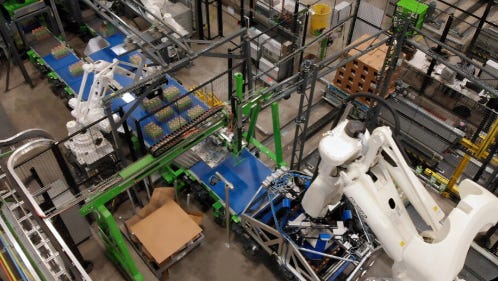Symbotic is a provider of robotics and software for the automation of warehouses. They recently won a large contract to automate all of Walmart’s distribution centers, bringing their backlog to a whopping $12 billion. This practically guarantees strong revenue growth for the coming four years. Their other clients include Albertsons, Target, Giant Tiger and C&S Wholesale Grocers.
The company’s systems manage the complete chain of warehouse operations, from the time merchandise is off-loaded from the trucks, to the storage and retrieval of inventory, to the preparation of shipments to retail stores. The platform is composed of de-palletizing robotic arms, which pick cases from newly arrived pallets; atomizing robotic arms, which put the cases in scanning tunnels; autonomous mobile robots, which store and retrieve cases; and palletizing robots that stack pallets with the needed SKUs (storage keeping units) to be shipped to the retail stores.
On the image below, the de-palletizing robotic arm is the large one on the right. It takes an entire layer of cases from a pallet at once and puts it on the conveyor belt to be sent to the next cell in the automated chain.

Subsequently, atomizing robotic arms organize the individual cases to go through a scanning tunnel, where each product’s dimensions are scanned as well as health checks being performed to check for damage. Any case that the system determines is damaged is set aside so that a human worker can inspect to either repair or reject the goods.
Upon exit from the scanning tunnel, the cases move to lifts where they’ll be brought up to the selected level in the warehouse. At each level, cases are placed onto buffer shelves where they’ll be picked up by autonomous mobile robots.
The overall warehousing structure of Symbotic’s system is composed of three feet tall levels stacked on top of each other. Each level contains a series of parallel aisles for the robots to travel to the storage locations.
The software system uses AI to determine the cases’ optimal location in order to reduce robot travelling times. Symbotic claims to have the fastest robots in the industry, travelling through the warehouse at speeds of 25 mph.
The mobile robots are automatically recharged by charge plates integrated into the floors, allowing them to work continuously. The bots are also interchangeable so if one needs to be taken out of production for maintenance, the software will assign its tasks to another one.
For shipment, the mobile bots retrieve cases and bring them to outbound lifts from where the cases are loaded onto conveyor belts. At the end of each belt, palletizing robotic arms stack the cases onto pallets, from where they are loaded onto trucks. Pallets are built according to the retail stores’ aisles so that the goods can rapidly be shelved once in store.
Below are what finished pallets look like:
The whole system is designed so that there isn’t a single point of failure. There are a multitude of robots, lifts and conveyor belts so that any task can always be taken over. Additionally, all equipment has a modular design so that components can easily be swapped on site.
Symbotic’s software provides analysis and predictions of inventory levels, throughput, system performance and maintenance needs. According to the company their platform has an accuracy of more than 99.99%.
Do me a favor and hit the subscribe button. Subscriptions let me know you are interested in research like this, which is a good motivation to publish more of the analysis I’m carrying out. Special thanks to the 400 subscribers so far!
The installed system is estimated to have a lifetime of 25 to 30 years. It can be installed in distribution centers of various sizes and shapes due to its modular design. Meaning that should the customer’s demand increase in the future, the system can be easily extended. A typical deployment takes around 6 to 12 months once the contract has been negotiated.
The company was founded in 2006 by Rick Cohen, who’s still the current CEO and Chairman. His grandfather started C&S Wholesale grocers, which he took over in 1989. Experiencing firsthand how low margin and inefficient wholesale businesses are due to high labor costs, Cohen came up with the vision to have fully automated warehouses. Over its history Symbotic has spent over $700 million to achieve this objective.
For premium subscribers we’ll review:
The competitive landscape
The potential future market size
The company’s financials and valuation
Concluding thoughts and whether it sense to invest here





